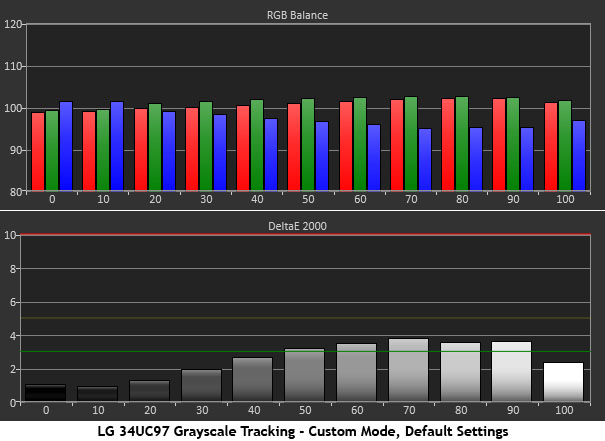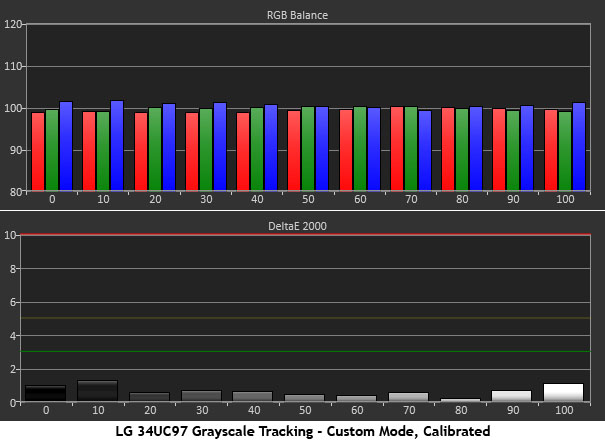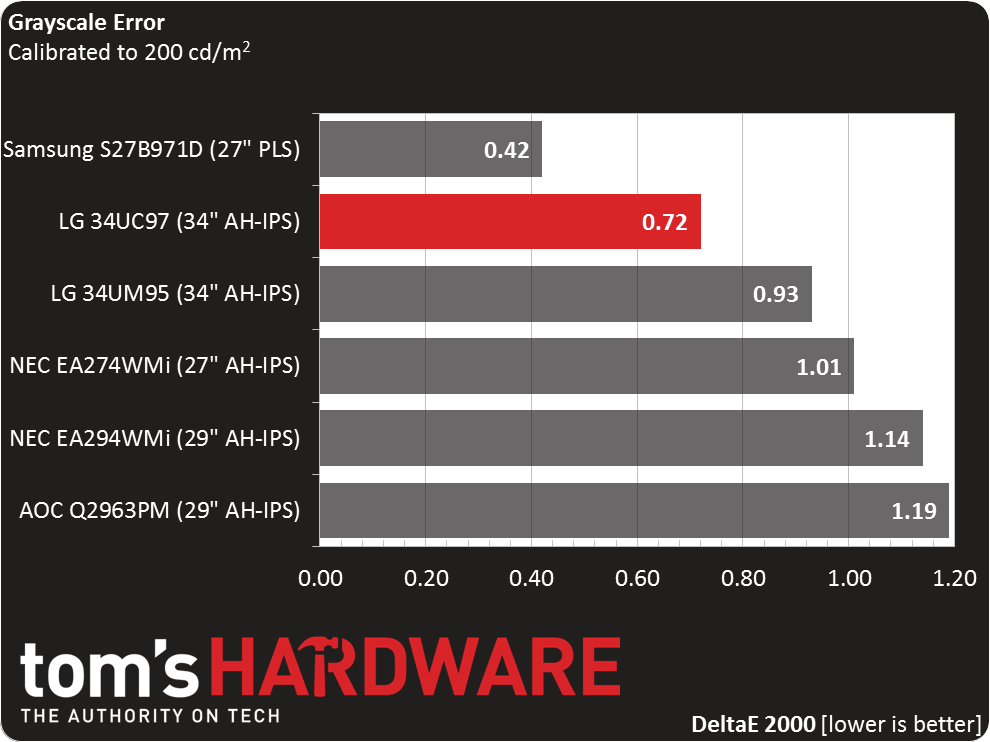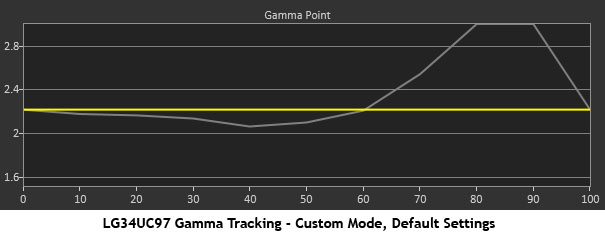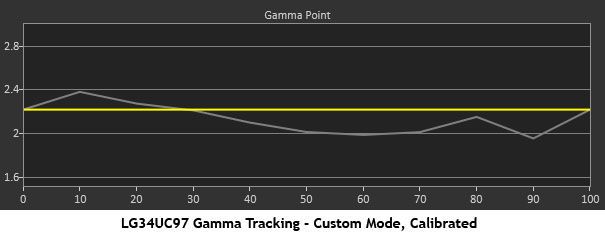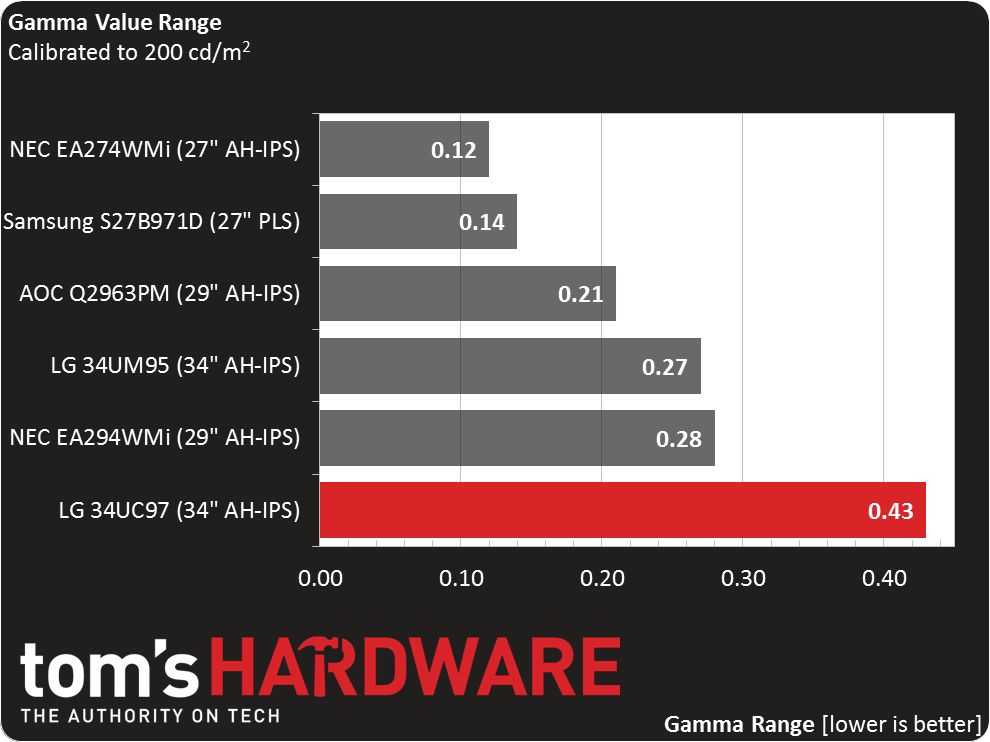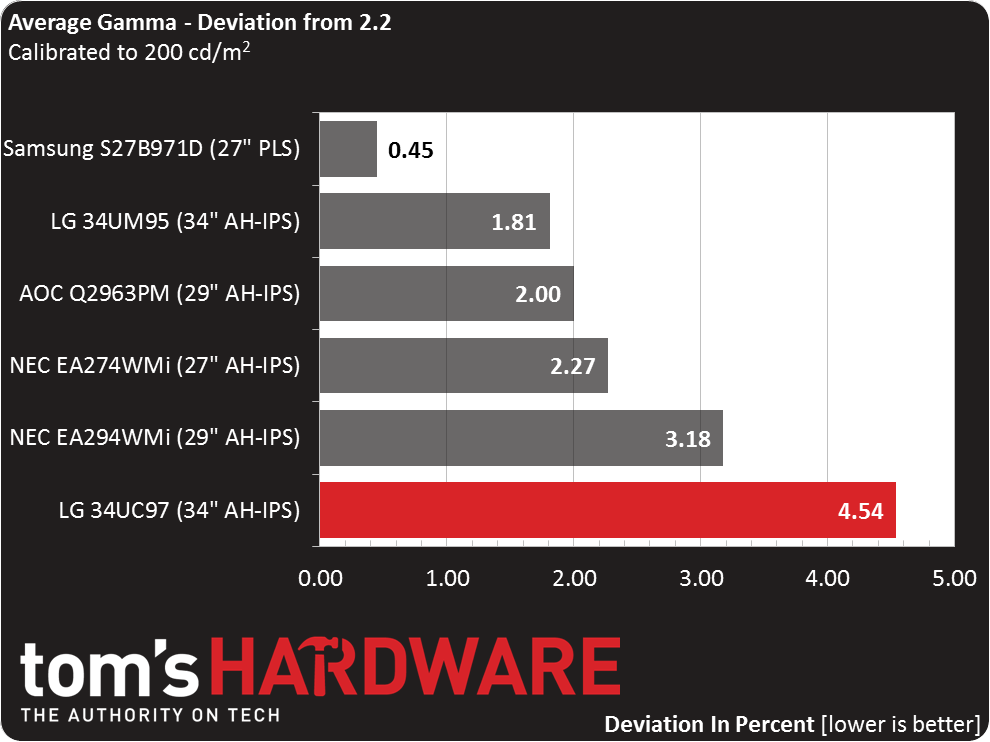LG 34UC97 34-Inch Ultra-Wide Curved Monitor Review
Yes, curved monitors are a thing now. We got our hands on LG's 34UC97 sporting a 34-inch width, 21:9 aspect ratio and 3440x1440 native resolution. It's pricey; is worth the premium you'll pay to be the first one on your block with this screen, though?
Why you can trust Tom's Hardware
Results: Grayscale Tracking And Gamma Response
Our grayscale and gamma tests are described in detail here.
The 34UC97 comes with a factory-certified calibration in the form of a test result data sheet. LG measures grayscale tracking and gamma for each sample as it comes off the manufacturing line. Our out-of-box results, while decent, are not quite as good as claimed. The likely reason is that LG uses DeltaE 94 to track errors and we use DeltaE 2000, which is more stringent. Our analysis definitely falls in the realm of nit-picking, however. Aside from tiny aberrations in the 50- to 90-percent levels, this is good tracking.
After calibration, we achieved a superb result with no issues at all. The 34UC97 is obviously capable of professional-level accuracy. Given that it costs as much or more than many pro models, that’s a good thing.
Here is our comparison group:
A result of 2.57 DeltaE is perfectly respectable for any business-class screen. If you just want to plug and play with the 34UC97, you will be very satisfied with its image quality.
Of course, .72dE is even better. It's a worthwhile improvement to the monitor's grayscale tracking. We’re glad to see that the two most expensive displays include factory calibrations and can live up to their billing.
Gamma Response
Even though the 34UC97 ships in a factory-calibrated state, there is one important thing you must do if you want proper gamma tracking: turn off the Smart Energy Saving feature. If you leave it on, you’ll see a little brightness pumping in the image as content changes from dark to light. In our tests, each pattern flickered a bit as brightness increased. It’s a little like the auto-iris on a projector, except it does nothing to improve black levels.
Get Tom's Hardware's best news and in-depth reviews, straight to your inbox.
We left the gamma preset alone and turned off SES. The resulting trace isn’t as flat as we’d like, but it’s not too bad. The impact on picture quality is barely noticeable. In the mid-tones you might see a slight flattening of the image. Most users won't perceive a problem, though.
Here is our comparison group again:
The slightly wavy tracking results in a last-place finish. Gamma values range from 2.37 to 1.94. It’s not that bad, but the other displays fare better.
We calculate gamma deviation by expressing the difference from 2.2 as a percentage.
The average value is 2.10, which is 4.54 percent below our standard of 2.2. We tried using the next-darker gamma preset, but this resulted in white balance issues at the higher levels. This is the only area where the 34UC97 could use some improvement. Color, as you’ll see on the next page, is quite good, as are the contrast and grayscale results we’ve recorded so far.
Current page: Results: Grayscale Tracking And Gamma Response
Prev Page Results: Brightness And Contrast Next Page Results: Color Gamut And Performance
Christian Eberle is a Contributing Editor for Tom's Hardware US. He's a veteran reviewer of A/V equipment, specializing in monitors. Christian began his obsession with tech when he built his first PC in 1991, a 286 running DOS 3.0 at a blazing 12MHz. In 2006, he undertook training from the Imaging Science Foundation in video calibration and testing and thus started a passion for precise imaging that persists to this day. He is also a professional musician with a degree from the New England Conservatory as a classical bassoonist which he used to good effect as a performer with the West Point Army Band from 1987 to 2013. He enjoys watching movies and listening to high-end audio in his custom-built home theater and can be seen riding trails near his home on a race-ready ICE VTX recumbent trike. Christian enjoys the endless summer in Florida where he lives with his wife and Chihuahua and plays with orchestras around the state.
-
Grognak I sure wish I could afford a screen like that, or the rig to go with it. Still, it's interesting how 21:9 just feels more natural when human FOV is about 4:3. It makes for great gameplay experiences, especially in first person games.Reply -
Sanjirox Maybe it's 120 degrees per eye in which case 4:3 is a perfect match if you can only use one eye.Reply -
arossetti Waiting to see the new gaming model -u67. I'm sure the price on that one U.S. gonna suck too! But it is like buying two monitors.Reply -
Merry_Blind @Grognak Interesting! I've always wondered what was the actual aspect ratio of our vision. That 4:3 you talk about, is it per eye individually? or the two combined together?Reply -
Fokissed Human FOV, according to wikipedia:Reply
"The approximate field of view of an individual human eye is 95° away from the nose, 75° downward, 60° toward the nose, and 60° upward."
"With eyeball rotation of about 90° (head rotation excluded, peripheral vision included), horizontal field of view is as high as 270°."
This means 155°:135°(31:27, very squarish) for nonmoving eyes, and 270°:135°(2:1) for moving eyes. -
RedJaron I think it's unforgivable that they didn't pack the USB cable. A USB3 A-to-B cable is not something most people have just have sitting on a shelf. You could argue that someone spending $1300 on a monitor has the money to pick one up, but I say for $1300 LG could have included a $5 cable in the box. Just ridiculous.Reply -
teahsr We know this is an expensive piece of equipment, but there isn’t anything else like the 34UC97 out there.Reply
^^Except my Dell U3415W that is.....which is awesome..
Now that 3440x1440 is around and more manufacturers are making this resolution, can we get it included in reviews?
